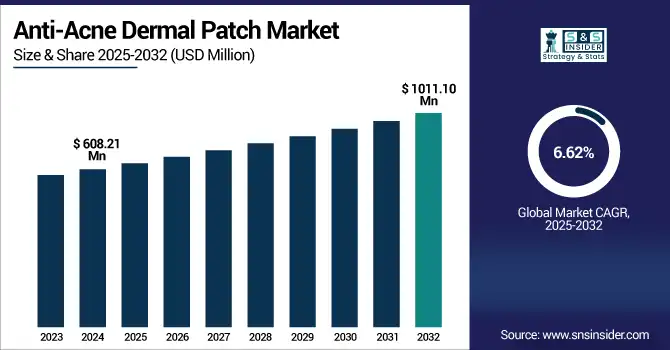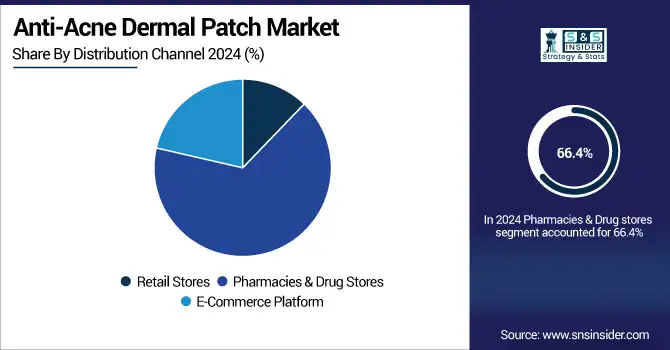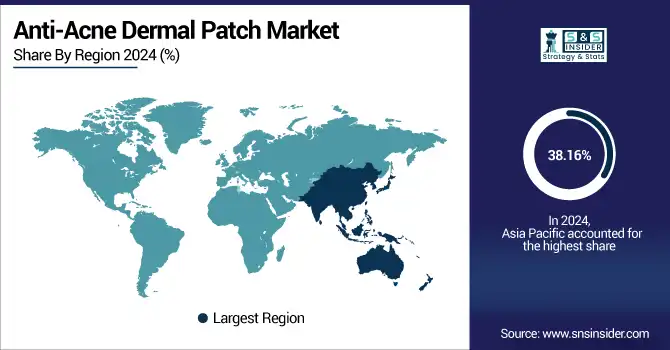Anti-Acne Dermal Patch Market Report Scope & Overview:
The anti-acne dermal patch market size was valued at USD 608.21 million in 2024 and is expected to reach USD 1011.10 million by 2032, growing at a CAGR of 6.62% over the forecast period of 2025-2032.
The global anti-acne dermal patch market is growing significantly, driven by the increased incidence of acne, particularly in adolescents and young adults. Increasing consumer focus on skincare product convenience, non-invasive nature, and rapid mode of action is driving the demand for hydrocolloid and microneedle patches. Growing skin health awareness, increased influence from social media, and a spike in e-commerce skincare products sales are increasing adoption through the roof. Moreover, the rise of clean-label and dermatologist-recommended products is influencing product innovations associated with the growing demand for anti-acne patches globally.

To Get more information on Anti-Acne Dermal Patch Market - Request Free Sample Report
The U.S. anti-acne dermal patch market size was valued at USD 111.62 million in 2024 and is expected to reach USD 191.07 million by 2032, growing at a CAGR of 7.01% over the forecast period of 2025-2032.
The North American anti-acne dermal patch market is dominated by the U.S., which is poised to dominate the regional market owing to high consumer awareness levels, demand for non-invasive skincare solutions, and availability of advanced patch technologies. The strong e-commerce infrastructure in the country and the impact of dermatologists and social media trends have led to faster uptake amongst all age groups, with teenagers and young adults leading the way.
Market Dynamics:
Drivers
-
Increasing Global Prevalence of Acne is Expected to Boost Demand Over the Forecast Period
Almost 9 in 10 adolescents are affected by acne around the globe, and the condition is becoming more prevalent in adults now, particularly in women. As the prevalence of acne increases, the need of the hour for patients is an easy-to-use, fast acne treatment for acne management. Unlike systemic medicines that can treat a wider area, anti-acne dermal patches have a mode of direct action on local lesions, offering very targeted and effective treatment while continuing to be free from systemic effects. More consumers, having learned that acne care is not just for teenagers but for all ages and in every geography, are embracing patches as a practical complement to their other forms of skin care.
-
OTC (over-the-counter) Skincare Solutions Demand is On the Rise, Driving Market Growth
Consumers are looking for more and more treatments in the form of over-the-counter (OTC) skincare products that they can purchase and use without having to go visit a dermatologist. People want convenience and fewer hassles in this post-pandemic, and anti-acne patches come right with all these needs, which provide relief with a small application. The combination of being easy to use, the fact that they are now sold in retail pharmacies, beauty stores, and online, and marketed as delivering dermatologist-formulated results, has all contributed to their growing popularity. This trend is evident particularly in urban and tech-savvy populations when it comes to OTC.
For instance, brands such as Go-To Skincare have further reinforced that longevity in OTC solutions by introducing sleek, super-thin Spot Stoppers containing salicylic acid and tea tree oil.
Enter micro-dart patch technology (such as the Deep Blemish Microdarts from PeachSlices), which is being hailed for speeding up healing with a more accurate ingredient delivery and deeper penetration.
Restraint
-
Market Growth is Hindered by Product Saturation and High Competition
The anti-acne dermal patch has attracted a bevy of newcomers, with everything from mass to indie skincare brands releasing their formulations. Such a rapid influx of products has paved the way for product saturation, therefore, limiting consumer' ability to differentiate their offerings. Since most patches are made with the same ingredients (for example, salicylic acid or hydrocolloid) with the same benefits, it can be difficult for brands to offer something new or different. Heightened competition leads to pricing pressures, decreased brand loyalty, and a constant need for companies to innovate just to maintain share of voice.
Segmentation Analysis:
By Type
The chemical-based segment dominated the anti-acne dermal patch market share with a 52.13% in 2024, due to its well-grounded results in a short span for acne treatment. They contain active ingredients such as salicylic acid, benzoyl peroxide, or tea tree oil that are well-known and clinically proven to decrease inflammation, unclog pores, and reduce acne lesions. The extensive availability in more retail and pharmacy locations, high physician endorsements (i.e., dermatologist boards) in prior years, and familiarity by the consumer jointly played a small but significant role in their leading market share.
The herbal-based segment is projected to grow at the fastest rate throughout the forecast period. The rise is supported by growing consumer desire to seek out naturally derived, gentle, and clean-label skincare products, especially from those with sensitive skin or who are concerned about the use of harsh chemicals. With the surge of organic beauty trends and the increase in demand for plant-based formulations such as Centella Asiatica, calendula, or green tea-infused patches, those health-conscious consumers are being drawn to the stars. Furthermore, the rising popularity of K-beauty and Ayurvedic influences continues to increase the need for herbal anti-acne products.
By Age Group
The anti-acne dermal patch market is dominated by the 18 to 44 segment in 2024, due to the vast population of acne-suffering individuals, along with greater purchasing ability in this age group. But the older set of this demographic is becoming more vigilant about skincare thanks to social media, beauty influencers, and a rising trend towards non-invasive, quick-fix treatments. This segment consists of some professionals and young adults who place a priority on appearance and convenience, which makes them key consumers of the cutting-edge discreet plans, including anti-acne dermal patches as part of a day-to-day skincare routine.
The fastest growing segment over the forecast period is the 10 to 17 segment. This is largely due to the acne in teens, as a result of hormonal changes. Moreover, rising consciousness on the use of skincare from a young age, accessibility to online skincare content, and the rise of dermatological products targeting teens have also been driving demand. Dermal patches among teens are also thriving as parents opt for solutions that are safer and easier to use over more complicated treatments and want dermatologist-recommended solutions.
By Distribution Channel
The pharmacies & drug stores segment dominated the anti-acne dermal patch market with a 66.4% market share in 2024, owing to high consumer confidence and the availability of dermatological products in pharmacies. These places are the first touchpoint where people can go to get over-the-counter acne treatments, with pharmacists supporting the recommendations. In-store deals and consultation have kept retail shop holders dominant in the market segment due to the broad availability of medically approved products.
The e-commerce platform segment is expected to see a significant CAGR for the duration of the forecast period. Driven by rising internet consumption, home delivery convenience, and an increasing preference for private skin-care buying. The broad product range with competitive prices and user reviews on the web helps consumers in their purchasing decisions. E-commerce is being quickly adopted by tech-savvy young consumers through social media marketing, influencer partnerships & subscription-based services selling skincare.

Regional Analysis:
The Asia Pacific region dominated the anti-acne dermal patch market with a 38.16% market share in 2024 due to the higher prevalence of acne, particularly within the adolescent and young adult populations. South Korea, Japan, and China lead in skincare science and market consumption, with hydrocolloid and herb-based patches permeating the market. Moreover, the cultural focus on clear skin, the early introduction of skincare products to children, and the K-beauty wave have greatly helped the region to dominate the market.
North America is expected to be the most lucrative region for the anti-acne dermal patch market with a 7.01% CAGR over the forecast period, driven by high consumer awareness, social media influence on the current generation, and high access to non-invasive skincare methods. This trend has recently gained momentum, especially among U.S. consumers, who are showing increased interest in clean-label and dermatologist-recommended acne ingredients, with e-commerce and many direct-to-consumer brands making products very accessible. That boom also comes from a major move towards self-care centered around skin health, particularly with Gen Z and millennial consumers.
In Europe, the anti-acne dermal patch market is growing with high consumer preference for natural and herbal-based skin-care products. High awareness of acne, rising sedentary lifestyle, and growing social media impact are creating growth opportunities for key markets, including the UK, Germany, France, Italy, and Spain. Regional market momentum is also gaining from the increasing demand for herbal patches owing to clean-label trends and favorable regulatory frameworks.
The anti-acne dermal patch market trend is moderately growing in Latin America as awareness regarding skincare routines is increasing, along with the increasing craze for non-invasive procedures. The social media-enabled rise of Korean skincare practices has also increased demand for OTC acne solutions in the country. An increase in the availability of dermal patches through retail and e-commerce channels enhances reach to consumers.
The anti-acne dermal patch market analysis is constantly evolving in the Middle East & Africa (MEA) on account of the rising urbanization, young population, and climbing demand for cosmetic and dermatological care. Demand is rising for skin-care products from the easy-to-use, results-oriented global south, from the UAE to Saudi Arabia to South Africa. Anti-acne dermal patches are becoming an easily accessible substitute for end-users in the region, propelled by the adoption of advanced skincare products amongst consumers.

Get Customized Report as per Your Business Requirement - Enquiry Now
Key Players
The anti-acne dermal patch market companies, COSRX, Nexcare, Peace Out Skincare, Hero Cosmetics (Mighty Patch), ZitSticka, Rael, Peter Thomas Roth, Starface, DermaAngel, 3M, and other players.
Recent Developments
-
June 2023 – Peace Out Skincare, the original acne lifestyle brand built on inclusivity and skin positivity, continues to spearhead the market with game-changing, one-step solutions for everyday skincare issues. The brand believes in treating acne where it originates, providing clean, efficient, and first-to-market solutions that yield visible results. Peace Out Skincare continues to be dedicated to offering affordable and truthful skincare for every complexion through science-driven, simple-to-use formulas.
| Report Attributes | Details |
|---|---|
| Market Size in 2024 | USD 608.21 million |
| Market Size by 2032 | USD 1011.10 million |
| CAGR | CAGR of 6.62% From 2025 to 2032 |
| Base Year | 2024 |
| Forecast Period | 2025-2032 |
| Historical Data | 2021-2023 |
| Report Scope & Coverage | Market Size, Segments Analysis, Competitive Landscape, Regional Analysis, DROC & SWOT Analysis, Forecast Outlook |
| Key Segments | • By Type (Chemical Based, Herbal Based) • By Age Group (10 to 17, 18 to 44, 45 to 64, 65+) • By Distribution Channel (Retail Stores, Pharmacies & Drug Stores, E-Commerce Platform) |
| Regional Analysis/Coverage | North America (US, Canada, Mexico), Europe (Germany, France, UK, Italy, Spain, Poland, Turkey, Rest of Europe), Asia Pacific (China, India, Japan, South Korea, Singapore, Australia, Rest of Asia Pacific), Middle East & Africa (UAE, Saudi Arabia, Qatar, South Africa, Rest of Middle East & Africa), Latin America (Brazil, Argentina, Rest of Latin America) |
| Company Profiles | COSRX, Nexcare, Peace Out Skincare, Hero Cosmetics (Mighty Patch), ZitSticka, Rael, Peter Thomas Roth, Starface, DermaAngel, 3M, and other players. |

